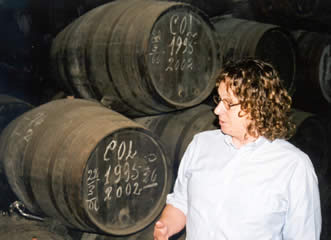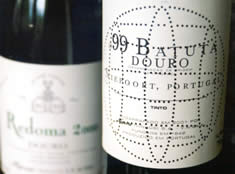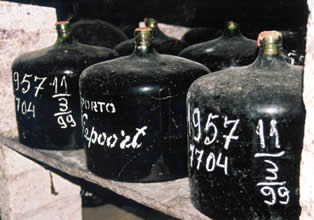
|
The
Douro revolution Part 2 Wednesday May 22nd 2002, Alistair
Little, Soho
I’ve been following the striking table wines from Dirk Niepoort with some interest over the last couple of years, and so I was glad that Danny Cameron (of Raymond Reynolds, the UK importers) invited me to a winemaker’s dinner with Dirk in the week of the London trade fair. I was even more pleased when I found out that Danny had seated me next to Dirk, which gave me an ideal chance to get to understand what he is trying to do with his wines. Straight away, I asked what his winemaking philosophy was.
‘I like wines with extremes’, he explained. ‘As rich and tannic
as possible, but they have to have harmony’. So
what does he like to drink at home? This is always a revealing question. For
whites, he prefers Mosel Riesling (Haag, Loosen and Willi Schaefer are
mentioned) and white Burgundy. He likes Champagne, too. And reds?
‘Red Burgundy, when it is very good, is the best wine in the
world’. We began tasting with Dirk’s whites. White wines are rare
in the Douro. The problem is that it’s simply just too hot to grow
white grapes successfully in most parts of the region. However, since
1995 Dirk has fashioned a very successful white Redoma by using grapes
grown in vineyards over 400 m in altitude, which helps preserve
acidity. The Reserva is a selection of the finest barrels, aged for
longer in mostly new oak.
Redoma Branco Reserva 2000 Rosé 2001 There are now four red wines in the Niepoort stable. The top
two, Batuta (first vintage 1999) and Charme (first vintage 2000) will
only ever be made in tiny quantities. Redoma has been around for a
while (the first vintage was 1991, after an experimental wine called
‘Robustus’ was made in 1990) and the style has been evolving since
them until the benchmark year of 1999. This was the vintage that Dirk
took on new winemaker Jorge Serôdio Borges, and he now feels that
he’s finally hit on a style that represents what he wants to achieve
with this wine. Dirk has given Jorge oversight of the fourth wine,
Quinta de Nápoles, and it’s interesting to see the stylistic
differences between this and the Redoma. Dirk says that he had been
looking for someone to work with him for five years, until he found
Jorge. He was looking for someone ‘technically better and
different’, but at the same time someone who would understand him.
Dirk says that he and Jorge have a very good relationship, and he
allows Jorge more-or-less free rein with Nápoles. Quinta de Nápoles 2000 Redoma 1999 Redoma 2000 (cask sample) With Batuta, Dirk’s aim is to make a ‘monster' wine, but
at the same time one that it extremely elegant. Rather enigmatically
he says, ‘I like
wines that are a bit in excess, but always tasting the opposite of
what they are’. In contrast, with Charme his aim is ‘finesse,
finesse, finesse’. Charme is an unusual wine in several respects.
First, it’s made in a slightly surprising way. The grapes are foot
trodden in lagares (large, shallow stone troughs) with the stems, which you’d think would result in
a harsh, tannic wine. But Dirk’s view is that foot-treading with
stems can actually produce elegant wines, and he cites Domaine de la
Romanée Conti as his precedent. ‘It’s very difficult to make wine
with stems’, he says. ‘If they are too green, they result in
aggressive, unbalanced wines with off flavours’. Timing the pressing
correctly is also important. ‘In 2001 we missed pressing of one
lagar by five hours. It won’t be a Charme.’ Interestingly, Dirk
alludes to the fact that his inspiration for Charme comes from Grand Cru red Burgundy. Burgundy-like wines from the Douro? Watch this
space. The other unusual thing about this inaugural Charme is that it
received Pingus-like 200% new oak treatment (malolactic fermentation
in new barrels followed by racking to more new barrels). Dirk say that
this is not an experiment he will repeat, although the result is not
as oaky as you’d think it might be. Batuta 1999 Charme 2000 Batuta 2000 (cask sample)
Next, a real treat. I had several glasses of this... 1970 Niepoort Vintage Port It was getting late and a number of people had already left.
But more was to come. To the remnant, Dirk poured his three top 2000
ports blind, and invited comments. Vintage 2000 Passadouro 2000 Secundum 2000 By this stage I was full (we
hadn’t been spitting). I very quickly warmed to Dirk, and his
passionate approach, always seeking to do better and push back the
boundaries further. But this isn’t random experimentation: he seems
to have a clear idea of where he wants to go. These truly are
extraordinary wines. During the course of the evening, Dirk invited me
to visit the Douro and experience first hand some of the exciting
developments currently taking place. It’s not in my nature to
decline such an invitation…
see also: Dinner with Dirk Niepoort 2 (May 2003) and 3 (May 2004); weekend in Porto with Dirk Niepoort (March 2004) |

 Redoma
Branco 2000
Redoma
Branco 2000